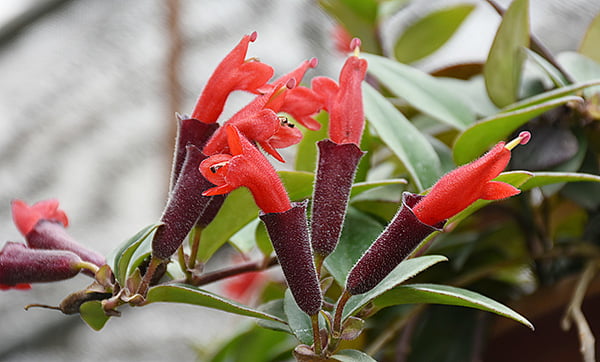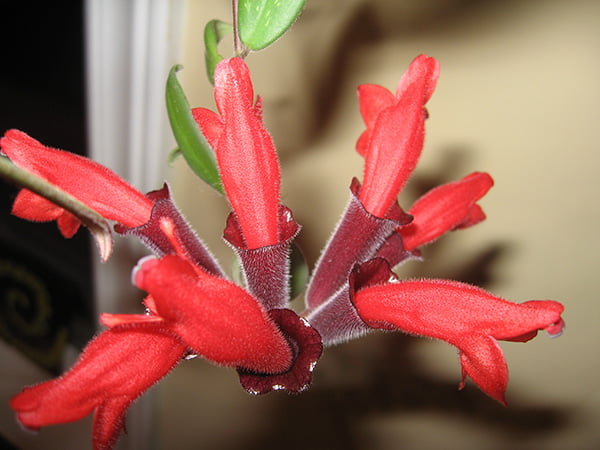Looking for a unique and stunning houseplant to add to your collection? Look no further than the Lipstick Plant. This tropical beauty gets its name from its striking, tube-like flowers that resemble a tube of lipstick. This cascading plant looks great in a hanging basket; the flowers are show-stopping. Lipstick plant flowers are bright red and push out of a purple bud, like lipstick coming out of its tube! But there's more to this plant than just its stunning blooms - it's also incredibly easy to care for and can add a touch of exotic beauty to any space.
In this article, we'll explore everything you need to know about caring for a Lipstick Plant, including how to propagate, water, and light. These lipstick plant care tips will help your lipstick plant to thrive. So, let's dive in and discover the beauty of this eye-catching houseplant!
Botanical Name
Common Name
Plant Type
Mature Size
Sun Requirement
Soil Type
Hardiness Zone
Pet Friendly
Aeschynanthus radicans
Lipstick plant, lipstick vine, basket vine
Perennial
1 to 3 feet tall and 1 to 2 feet wide
Bright filtered light
Well drained
10a-11a USDA
Yes
What Are Lipstick Plants?
The lipstick plant (Aeschynanthus radicans), also known as basket vine, gets its name from its unique, tubular flowers! The flower buds are long, burgundy, and fuzzy. As the bright red flowers open and push out of their buds, it looks like red lipstick coming out of lipstick tubes! The flowers are a vibrant red with yellow throats.
The flowers are the star of the lipstick plant show, but the foliage isn't anything to shake a stick at either. Cascading vines filled with waxy, deep green leaves will fill out any basket or pot well.
If you're a fan of lipstick plants, don't feel that you need to stop at one! There are many different varieties of lipstick plants, so why not start a collection? Here are some favorite lipstick plant varieties to keep your eyes open for:
Curly Leaf (Aeschynanthus radicans 'Curly') - This variety of lipstick plants has curly leaves! Long vines filled with these curled leaves give the entire plant a wavy appearance.
Mona Lisa (Aeschynanthus radicans 'Mona Lisa') - The coloring of this variety is lovely. The leaves of the Mona Lisa are smaller but a darker green. The dark leaves contrast nicely with the orange color of the flowers.
Rasta (Aeschynanthus radicans 'Rasta') - Also known as the "twisted lipstick plant," this variety doesn't just have curled leaves - they're downright twisted upon themselves! It makes for a stunning houseplant, even when it's in its dormant season.
Black Pagoda (Aeschynanthus radicans 'Black Pagoda') - This hybrid variety has mottled, multi-colored foliage and bright flowers that blend from yellow to orange to red.
The lipstick plant's native habitat is the tropical rainforest of Southeast Asia. There, it grows as an epiphytic plant. That means this plant grows on another plant rather than in the soil. They can be found growing on tree branches. It grows just fine indoors in a pot of soil as long as you get the environmental needs right!
Lipstick Plant Care Requirements
Light
Like all tropical plants, lipstick plants need adequate light, but too much direct sunlight will scorch them and lead to leaf drop. This is because it would originally grow under the canopy of large trees and receive an abundance of dappled, filtered sunlight.
The best location in your home for bright, indirect light will be a south-facing sunny window. An east-facing window may work if your morning sunlight isn't a harsh, bright light. If all of your available houseplant locations receive direct light, use a sheer curtain to help diffuse the light as it comes in.
Your lipstick plant can be grown outdoors during the warm summer months, but take care not to give it too much sunlight! In fact, a partial shade location will be best when your lipstick plant is outdoors, and there will be enough ambient light.
Water
Lipstick plants would rather be dry than wet. They're drought-tolerant plant that does not handle being overwatered well. On the other hand, however, you will quickly be dealing with leaf drops if the soil gets too dry.
The balance you need to strike is to only water when the top few inches are dry but never to let the rootball itself dry out. You should be fine as long as you always check the top layer of soil before watering and use a pot or hanging basket with adequate drainage holes.
Temperature
Unless you live in USDA Hardiness Zone 11, you'll be growing lipstick plants as indoor plants. This plant prefers a temperature range between 65 and 85 degrees Fahrenheit and does not handle cold well. You can place your lipstick plant outdoors during the summer, but as soon as the nighttime temperature dips below 50 degrees Fahrenheit, you'll need to bring your plant indoors.

Source: Flickr
Humidity
Plants from tropical regions love high humidity! But you don't need to turn your home into a greenhouse in order for them to thrive inside. You simply need to boost the humidity levels a bit in the air around your lipstick plant. There are a couple of different ways to do this.
Pebble Tray - Fill a tray will pebbles, then add water. Don't let the water level rise above the top of the pebbles! Then, set your lipstick plant pot on top of the pebble tray. As the water in the tray evaporates, it will increase the humidity in the air right above it.
Plant Grouping - Plants naturally increase the moisture in the air around them, so by grouping humidity-loving plants together, they'll help each other out!
Bathroom - Due to baths and showers, this is likely the most humid room in your house.
Humidifier - Run a small humidifier near your lipstick plants and other plants that need a moisture boost.
Misting - Misting the lipstick plant leaves with a spray bottle will not only give them the added moisture they need, but it will also take care of any dust that settles on them!
Soil
Lipstick plants need a neutral to alkaline potting medium that is very well-draining. Remember that in their native environments, lipstick plants would grow in an almost soil-free environment! You can use an African violet potting mix or make your own!
Start with standard potting soil. Add sphagnum moss - this will help with moisture retention around the roots. Then, add sand, perlite, or pumice to provide extra aeration and drainage. Finally, add some orchid bark or coco fibers. This help mimic the tree branches your lipstick plant would otherwise grow on!
Fertilization
Fertilizing your lipstick vine every other week during the growing season, spring and summer, will give you an abundance of bright red blooms. Apply a slow-release fertilizer, or use compost tea for an organic option that is unlikely to burn roots.
Pruning
Pruning your Lipstick Plant is an important step in maintaining a healthy lipstick plant, and it helps with its overall health and encourages it to form more flowers. Removing dead or diseased leaves prevents the plant from wasting energy on these non-functional parts and redirects its resources toward producing new growth and flowers. And since the flowers form at the leaf tips, pruning will help create more blooms.
To prune your Lipstick Plant, start by removing any yellow or brown leaves using a pair of sharp, sterile scissors or pruning shears. You can also pinch back the tips of the stems to encourage the plant to bush out and produce more flowers.
Pruning also helps to increase airflow and light penetration to the lower parts of the plant, which can stimulate the growth of new flower buds. So, by regularly pruning your Lipstick Plant, you can help to create a more lush, bushy plant with plenty of healthy foliage and beautiful blooms.

Source: Flickr
Propagation
It's easy to grow lipstick plants from soft stem cuttings. Here's how you do it:
Choose a stem with healthy growth, and use clean shears to clip off a stem cutting around 5 inches long. Choose a section free of blooms, and make your cut directly after a leaf node.
Remove all leaves from the cutting except for the last few at the tip.
Dip the cut end in a powdered rooting hormone. While not strictly necessary, it will encourage faster and stronger rooting.
Plant the cutting in a small container filled with a mixture of vermiculite and perlite. Place this pot in a bright location, and make sure to maintain consistent moisture. Place a small plastic bag over the top of the container to help trap humidity.
Roots will start forming in just two weeks! After a few weeks, you'll be able to transplant your propagated lipstick plant into its new pot.
Common Problems With Lipstick Plants
Proper lipstick plant care will typically mean that you won't have any pest or disease concerns! However, it does happen sometimes.
Pests
These hanging plants don't attract as many pests as the others. Spider mites, aphids, and mealybugs may come to your lipstick plant and cause a problem. These bugs like to drink the juice from your plant's leaves. If you find them, remove as many as possible by hand, spray the leaves off with a hose, and then treat them with neem oil or insecticidal soap.
Overwatering
The most common of these is root rot. You'll know you're dealing with root rot if the leaves start to turn yellow or brown but feel soft rather than crunchy. Unpot your plant, remove the rotten roots, and repot it with fresh soil.
Underwatering
On the other hand, if you don't water your Lipstick Plant enough, the leaves may start to wilt and drop. Make sure to water your plant thoroughly when the top inch of soil feels dry to the touch.
Lack of light
Lipstick Plants need bright, indirect light to thrive. If your plant is kept in a dimly lit area or is not getting enough light, it may not produce as many flowers or may start to drop leaves.
Are Lipstick Plants Pet Friendly?
Yes, lipstick plants are non-toxic and completely safe for pets and small humans.
